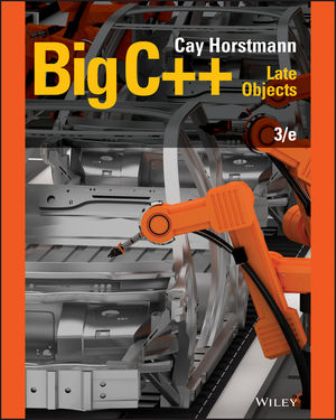Test Bank for (Chapter 1 – 17) Big C++: Late Objects, 3rd Edition, Cay S. Horstmann
$35.00 Original price was: $35.00.$26.50Current price is: $26.50.
Test Bank for (Chapter 1 – 17) Big C++: Late Objects, 3rd Edition, Cay S. Horstmann,
Test Bank for (Chapter 1 – 17) Big C++: Late Objects, 3rd Edition, Cay S. Horstmann pdf docx epub after payment.

1. Which one of the following options refers to a collection of programs that a computer executes?
A. Software Answer
B. Assembler
C. Instructions
D. Source code
Section Ref 1.1
Title Which (term) refers to a collection of programs?
section 1.1 What Is Programming?
Difficulty Easy
id testbank-bc-2-ch01-1
2. Computers are machines that
A. Design computer programs
B. Execute programs Answer
C. Carry out a very narrow range of tasks
D. Are imprecise and slow
Section Ref 1.1
Title What kind of machines are computers?
section 1.1 What Is Programming?
Difficulty Easy
id testbank-bc-2-ch01-2
3. Computer programming is
A. The speed with which a computer operates
B. The collection of peripheral devices connected to a computer
C. The storage of data in the form of words and pictures
D. The act of designing and implementing a computer program Answer
Section Ref 1.1
Title What is computer programming?
section 1.1 What Is Programming?
Difficulty Easy
id testbank-bc-2-ch01-3
4. Consider the following statements regarding computers:
I. Computers can execute a large number of instructions in a fraction of a second.
II. Computer application areas mainly target the research and scientific communities.
III. The physical components of a computer constitute its hardware.
IV. Unlike humans, a computer never gets bored or exhausted on performing repetitive tasks.
Which one of the following options is correct?
A. Only III is a valid statement.
B. I and III are valid statements.
C. I, II, and III are valid statements.
D. I, III, and IV are valid statements. Answer
Section Ref 1.1
Title Which statement(s) regarding computers is(are) correct?
section 1.1 What Is Programming?
Difficulty Easy
id testbank-bc-2-ch01-4
5. Consider the following statements about computer programs:
I. Computer programs can be written by someone who has a basic knowledge of operating a computer.
II. Computer programs can complete complex tasks quickly.
III. Large and complex computer programs are generally written by a group of programmers.
IV. Computer programs are composed of extremely primitive operations.
Which one of the following options is correct?
A. II and III are correct statements.
B. I, II, III, and IV are correct statements.
C. II, III, and IV are correct statements. Answer
D. I and IV are correct statements.
Section Ref 1.1
Title Which statement(s) regarding computer programs is(are) correct?
section 1.1 What Is Programming?
Difficulty Easy
id testbank-bc-2-ch01-5
6. Writing the program for a computer game with motion, graphics, and sound usually requires
A. one brilliant programmer writing a large number of simple instructions
B. a team of programmers writing a few complex instructions
C. one brilliant programmer writing a few complex instructions
D. a team of programmers writing a large number of simple instructions Answer
Section Ref 1.1
Title Who writes complexprograms?
section 1.1 What Is Programming?
Difficulty Easy
id testbank-bc-3-ch01-6
7. The Central Processing Unit is primarily responsible for
A. Performing program control and data processing Answer
B. Ensuring data persists when electrical power is turned off
C. Enabling a human user to interact with the computer
D. Interconnecting computers that are separated by distance
Section Ref 1.2
Title What is the function of a CPU?
section 1.2 The Anatomy of a Computer
Difficulty Easy
id testbank-bc-2-ch01-6
8. A single silicon chip made from potentially millions of transistors is called
A. A Central Processing Unit (CPU) Answer
B. Secondary Storage
C. A Hard Disk
D. An Optical Disk (such as a DVD)
Section Ref 1.2
Title What is a chip with transistors called?
section 1.2 The Anatomy of a Computer
Difficulty Easy
id testbank-bc-2-ch01-7
9. An example of an output device that interfaces between computers and humans is
A. The keyboard
B. The mouse
C. The speaker Answer
D. A microphone
Section Ref 1.2
Title What is an example of an output device that interfaces between humans and computers?
section 1.2 The Anatomy of a Computer
Difficulty Easy
id testbank-bc-2-ch01-8
10. An example of an input device that interfaces between computers and humans is
A. The microphone Answer
B. The monitor
C. The printer
D. The speaker
Section Ref 1.2
Title What is an example of an input device that interfaces between humans and computers?
section 1.2 The Anatomy of a Computer
Difficulty Easy
id testbank-bc-2-ch01-9
11. Programs that are not running are usually stored
A. in the CPU’s memory.
B. on the computer monitor.
C. in secondary storage. Answer
D. on a backup device that is in a different physical location from the computer.
Section Ref 1.2
Title Where are programs usually stored when they are not running?
section 1.2 The Anatomy of a Computer
Difficulty Easy
id testbank-bc-2-ch01-10
12. When a program begins to run,
A. It is moved from DVD to hard disk.
B. It is moved to the CPU’s memory. Answer
C. It is moved from the CPU’s memory to hard disk.
D. It must be connected to a computer network.
Section Ref 1.2
Title What happens when a program begins to run?
section 1.2 The Anatomy of a Computer
Difficulty Easy
id testbank-bc-2-ch01-11
13. Which one of the following typically provides data persistence without electricity?
I. The CPU’s memory
II. The hard disk
III. Secondary storage
A. I, II
B. I, III
C. II, III Answer
D. I, II, III
Section Ref 1.2
Title Which storage type provides data persistence without electricity?
section 1.2 The Anatomy of a Computer
Difficulty Easy
id testbank-bc-2-ch01-12
14. Which best describes the difference between primary and secondary storage?
A. primary storage is more expandable, while secondary storage is more flexible
B. primary storage is used only by the CPU, while secondary storage is used only by peripherals
C. primary storage is simpler to replace than secondary storage if it fails
D. primary storage is fast but costly, while secondary is slow, larger and cheaper Answer
Section Ref 1.2
Title Differences between primary and secondary storage
section 1.2 The Anatomy of a Computer
Difficulty Easy
id testbank-bc-3-ch01-14
15. A network controller is the device in a computer that
A. controls the internal network.
B. connects the computer to the internet or other network through a wire or wireless. Answer
C. connects the CPU to peripherals.
D. interfaces between a hard disk and other disks such as CDs and USB drives.
Section Ref 1.2
Title What is a network controller?
section 1.2 The Anatomy of a Computer
Difficulty Easy
id testbank-bc-3-ch01-15
16. The instruction “1011 0011” for a computer is an example of
A. assembly language.
B. high-level language.
C. bit language.
D. machine language. Answer
Section Ref 1.3
Title Computer Instruction Types
section 1.3 Machine Code and Programming Languages
Difficulty Easy
id testbank-bc-3-ch01-18
17. The C++ Language
A. was introduced in the 1980s.
B. is commonly used for embedded systems.
C. is commonly used for designing system software such as databases.
D. All of the above Answer
Section Ref 1.3
Title C++ Usage
section 1.3 Machine Code and Programming Languages
Difficulty Easy
id testbank-bc-3-ch01-19
18. Consider a scenario in which you develop a C++ program on a computer that has a Pentium processor and compile the
program into the corresponding machine language. What step should you take to run the same program on a computer that has
a different processor?
A. Copy the compiled machine language instructions to the computer that has a different processor.
B. Develop the same program again on the computer that has a different processor and recompile the program.
C. Recompile the C++ program on the computer that has a different processor. Answer
D. You cannot run the program on a computer with a different processor because C++, being a high-level programming
language, is machine dependent.
Section Ref 1.3
Title What step should you take to run a C++ program on a (different) processor?
section 1.3 Machine Code and Programming Languages
Difficulty Medium
id testbank-bc-2-ch01-13
19. High level programming languages
A. Are made up primarily of ones and zeros
B. Are independent of the underlying hardware Answer
C. Are not standardized
D. Use syntax that is close to the underlying hardware’s instruction set
Section Ref 1.3
Title What are the characteristics of high level programming languages?
section 1.3 Machine Code and Programming Languages
Difficulty Easy
id testbank-bc-2-ch01-14
20. Which one of the following translates high-level descriptions into machine code?
A. Assembler
B. Linker
C. Compiler Answer
D. Editor
Section Ref 1.3
Title Which translates high-level descriptions into machine code?
section 1.3 Machine Code and Programming Languages
Difficulty Easy
id testbank-bc-2-ch01-15











